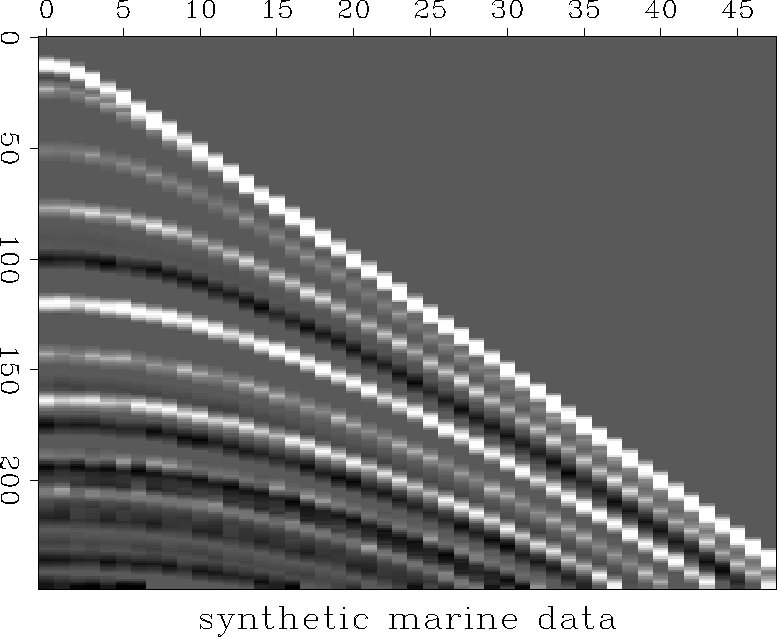|
synmarine
Figure 4 A frame from the synthetic marine data subroutine synmarine(). Press button for movie. |  |
Gravity is a strong force for the stratification of rocks, and in many places in the world rocks are laid down in horizontal beds. Yet even in the most ideal environment the bedding is not mirror smooth; it has some texture. We begin the study of offset with synthetic data that mimics the most ideal environment. Such an environment is almost certainly marine, where sedimentary deposition can be slow and uniform. The wave velocity will be taken to be constant, and all rays will reflect as from horizontally lying mirrors. Mathematically, texture is introduced by allowing the reflection coefficients of the beds to be laterally variable. The lateral variation is presumed to be a random function, though not necessarily with a white spectrum. Let us examine the appearance of the resulting field data.
Randomness is introduced into the earth with a random function of midpoint y and depth z. This randomness is impressed on some geological ``layer cake'' function of depth z. For every point in (y,z)-space, a hyperbola of the appropriate random amplitude must be superposed in the space of offset h and travel time t.
What does the final data space look like? This question has little meaning until we decide how the three-dimensional data volume will be presented to the eye. Let us view the data much as it is recorded in the field. For each shot point we see a frame in which the vertical axis is the travel time and the horizontal axis is the distance from the ship down the towed hydrophone cable. The next shot point gives us another frame. Repetition gives us the accompanying program that produces a cube of data, hence a move. This cube is synthetic data for the ideal marine environment. And what does the movie show?
subroutine synmarine ( data, nt,nh,ny, nz) integer nt,nh,ny, nz, it,ih,iy,is,iz, ns, iseed real data( nt,nh,ny), layer, rand01 temporary real refl(nz,ny), depth(nz) iseed= 1992; ns = ny do iz= 1, nz { # 0 < rand01() < 1 depth( iz) = nt * rand01(iseed) # Reflector depth layer = 2. * rand01(iseed) - 1. # Reflector strength do iy= 1, ny { # Impose texture on layer refl(iz,iy) = layer * (1. + rand01(iseed)) } } call null( data, nt*nh*ny) # erase data space do is= 1, ns { # shots do ih= 1, nh { # down cable h = (g-s)/2 do iz= 1, nz { # Add hyperbola for each layer iy = (ns-is)+(ih-1) # y = midpoint iy = 1 + (iy-ny*(iy/ny)) # periodic with midpoint it = 1 + sqrt( depth(iz)**2 + 25.*(ih-1)**2 ) if( it <= nt) data(it,ih,is) = data(it,ih,is) + refl(iz,iy) }}} return; end
A single frame shows hyperbolas with imposed texture. The movie shows the texture moving along each hyperbola to increasing offsets. (I find that no sequence of still pictures can give the impression that the movie gives). Really the ship is moving; the texture of the earth is remaining stationary under it. This is truly what most marine data looks like, and the subroutine synmarine() simulates it.
|
synmarine
Figure 4 A frame from the synthetic marine data subroutine synmarine(). Press button for movie. |  |
Comparing the simulated data to real marine-data movies, I am impressed by the large amount of random lateral variation required in the simulated data to achieve resemblance to field data. The randomness seems too great to represent lithologic variation. Apparently it is the result of something not modeled. Perhaps it results from our incomplete understanding of the mechanism of reflection from the quasi-random earth. Or perhaps it is an effect of the partial focusing of waves sometime after they reflect from minor topographic irregularities.